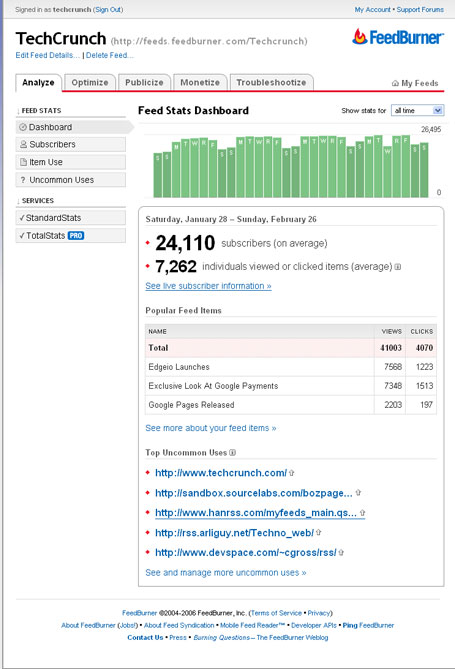Feedburner CEO Dick Costolo emailed Richard MacManus and me on Monday to give us a preview of what he calls “broad enhancement to our stats” that are being released later this morning.
I’ve had a chance to review the new functionality (screen shot below) and I agree that these changes are both needed and useful.
The key change is to give users more information on what items in feeds are actually getting “viewed” and clicked on. Until now bloggers could not get this information – analytics services like MeasureMap and BlogBeat give us good insight into what’s being done on the actual site, but unless a click through to the site occurs from a feed, there was little or no information on what was actually being read off site. FeedBurner’s new stats go a long way toward mitigating this problem.
They are also showing what they call “uncommon” sources which allow bloggers to see where their feeds are being read and re-used beyond the standard RSS readers like Rojo and Bloglines, and new tools for podcasters to track downloads.
Dick summarized all of the new features in his email:
The new features are:
a) Uncommon uses. We track 200k feeds and so we see everywhere feeds are used regularly. When we see someplace a feed is referenced or clicked that we don’t recognize as a common reference, we highlight it here in the dashboard and on the detailed uncommon uses page. Could be a cool little newfilter somebody wrote, could be a blog somebody assembled from feeds, could be a cool little web-based aggregator we’ve never heard of, could be blog spam. Whatever it is, we’ve found that publishers love to see these unique uses and references and that it’s very helpful to have something like feedburner that can leverage a broad base of common references to point out the uncommon ones. You can then “whitelist” or “hide” references you already know about (note that your own site will be an uncommon reference, whitelist that one right away), and you’ll never be Alerted to whitelisted domains on your dashboard again.
b) Better integration of item stats and feed stats, better clickthrough to items for more details
c) Reach! Now we start to give you an idea of what percent of your subscribers actually looked at or clicked on one of your items today. This is step one. We will spend a lot more time on reach based on how people react to v1 here. We know there’s much more to dive into on this.
d) Historical reach and subscription from the dashboard…..you can now click back through the days on the dashboard chart to see reach and item popularity by day.
e) Podcasters – better feed level download tracking. In addition to subscribers we now identify the number of people that actually downloaded a particular podcast. This will get even more robust in the future as we provide download numbers from the podcast on the site and sum that with the feed based downloads. This release is feed based downloads only.
This comes on the heals of FeedBurner’s 2 year birthday and announced funding from Union Square Ventures earlier this month. The company has raised a total of $10 million to date.
